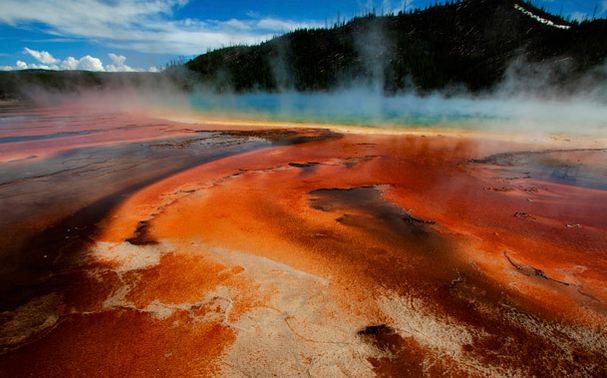The best view yet of the volcanic "plumbing system" powering the Yellowstone supervolcano confirms the presence of a dangerous magma reservoir 28 miles below the surface.
The first three-dimensional or 3D image of the inner workings of the Yellowstone supervolcano, the largest in the world, reveals an 11,200 cubic-mile magma reservoir below a previously known 2,500 cubic-mile magma chamber 12 miles deep.
Scientists said both reservoirs of hot rock are channels between a hotspot plume that might originate at the Earth's core and extend to the Yellowstone caldera. The two reservoirs are probably connected by a system of volcanic dikes and sills or tabular sheets of igneous rock intruded between and parallel with the existing strata, said scientists.
The amount of magma in the newly found reservoir is enough to fill the Grand Canyon nearly 14 times over.
The Yellowstone hotspot plume has been triggering eruptions for some 17 million years. The Yellowstone supervolcano has erupted thrice in the last two million years. A new eruption similar to any of these three events would have catastrophic consequences for the United States.
Another eruption might hurl some 640 cubic miles of debris into the sky, covering large portions of North America in ash and darkening skies for days. The chance the Yellowstone supervolcano will erupt anytime soon is quite low, however. It stands at only about 1 in 700,000 annually, said the Smithsonian.
"We can't say how much of a warning we would have," said Fan-Chi Lin of the University of Utah and co-author of the study about the new magma reservoir. He believes the warning signs "could be on the order of days to months to years".
He said it's probable there would be many warning signs of an eruption, including increased earthquake activity, ground uplift; trees killed by higher ground temperatures and a rise in the amount of volcanic gases spewing from the ground.
Yellowstone, the largest volcanic field in North America, is the home to a caldera called the Yellowstone supervolcano. The supervolcano is located mostly in Wyoming but extends into Idaho and Montana.
It's erupted three times: two million, 1.3 million and 600,000 years ago. Scientists said the previous giant eruptions of the Yellowstone Supervolcano probably lasted many, many months or even years.
Researchers developed a 3-D map of what's happening deep underground in the magma reservoirs by combining data from thousands of earthquakes. The new data revealed the new magma reservoir.



























